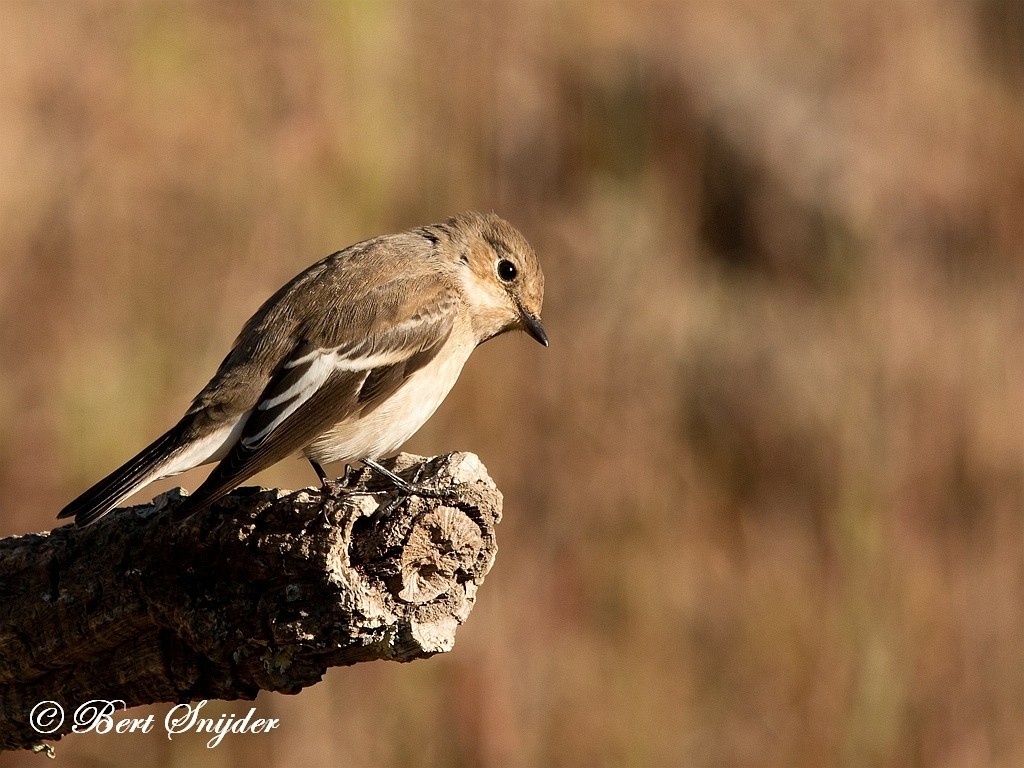Pied Flycatcher, Bonte Vliegenvanger, Trauerschnäpper, Papa-moscas-preto, Papamoscas Cerrojillo
Spotted on Monte Horizonte in the Alentejo region of Portugal. Pied Flycatcher sound
The Pied Flycatcher, Ficedula hypoleuca, is a small passerine bird in the Old World flycatcher family, one of the four species of Western Palearctic black-and-white flycatchers. It breeds in most of Europe and western Asia. It is migratory, wintering mainly in western Africa.

This is a 12-13.5 cm long bird. The breeding male is mainly black above and white below, with a large white wing patch, white tail sides and a small forehead patch. The Iberian subspecies iberiae (known as Iberian Pied Flycatcher) has a larger forehead patch and a pale rump. Non-breeding males, females and juveniles have the black replaced by a pale brown, and may be very difficult to distinguish from other Ficedula flycatchers, particularly the Collared Flycatcher, with which this species hybridizes to a limited extent.
The bill is black, and has the broad but pointed shape typical of aerial insectivores. As well as taking insects in flight, this species hunts caterpillars amongst the oak foliage, and will take berries. It is therefore a much earlier spring migrant than the more aerial Spotted Flycatcher, and its loud rhythmic and melodious song is characteristic of oak woods in spring.
They are birds of deciduous woodlands, parks and gardens, with a preference for oak trees. They build an open nest in a tree hole, and will readily adapt to an open-fronted nest box. 4-10 eggs are laid.
The very similar Atlas Flycatcher (Ficedula speculigera), of the mountains of north west Africa was formerly classed as subspecies of the Pied Flycatcher.
Other synonyms:
Asturian: Mosqueru Pintu
Breton: Ar flouperig brizh, Kelienaerig
Catalan: Mastegatatxes, Mosquiter de Schwarz, Papamosques negre
Catalan (Balears): Papamosques negre
Valencian: Mosquiter de Schwarz
Czech: Lejsek cernohlavý, lejsek èernohlavý
Welsh: Clochder y mynydd, Gwybedog brith, Gwybedwr du a gwen
Danish: Broget fluesnapper
German: Trauerschnaepper, Trauerschnäpper
English: European Pied Flycatcher, Pied Flycatcher, Western Pied Flycatcher
Spanish: Papamoscas Cerrojillo, Papamoscas collarino
Estonian: Metstikk, Must-kärbsenäpp
Basque: Euli-txori beltz, Mastegatatxes
Finnish: Kirjosieppo
Faroese: Flekkunápur
French: Gobemouche noir
Frisian: Bûnte Miggesnapper
Irish: Cuilire Alabhreac, Cuilire Alabhreach
Gaelic: Breacan Sgiobalt
Galician: Mastegatatxes
Manx: Skybbyltagh
Croatian: Crnoglava Muharica
Hungarian: Kormos légykapó
Icelandic: Flekkugrípur
Italian: Balia nera
Japanese: segurohitaki, Seguro-hitaki
Cornish: Gwybessor gwyn ha du
Latin: Ficedula atricapilla, Ficedula hypoleuca
Lithuanian: Margasparne musinuke
Dutch: Bonte Vliegenvanger
Norwegian: Sv.hv.fluesnapper, Svarthvit fluesnapper
Polish: mucholówka zalobna
Portuguese: papa moscas preto, Papa-moscas-preto
Romansh: sgnappamustgas nair
Scots: Breacan glas
Northern Sami: Girjelivkkár
Slovenian: crnoglavi muhar
Albanian: Mizakapësi i zi
Serbian: Crnoglava šarena muharica, šarena muharica
Swedish: Svartvit flugsnappare
Turkish: Kara sinekkapan
Travel Birdwatching Holiday Alentejo, Vacation Portugal for birders guided birdwatching Tours and Trips.